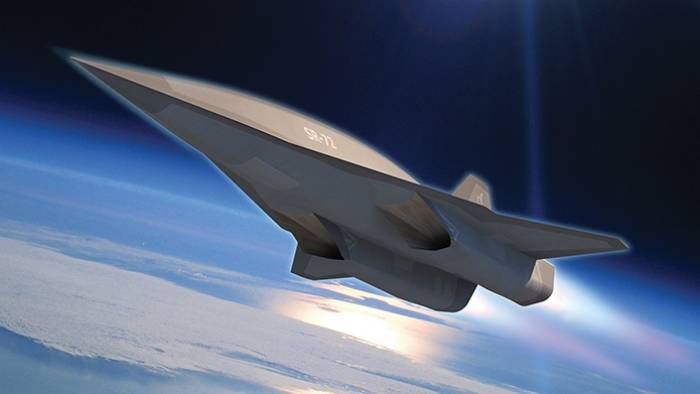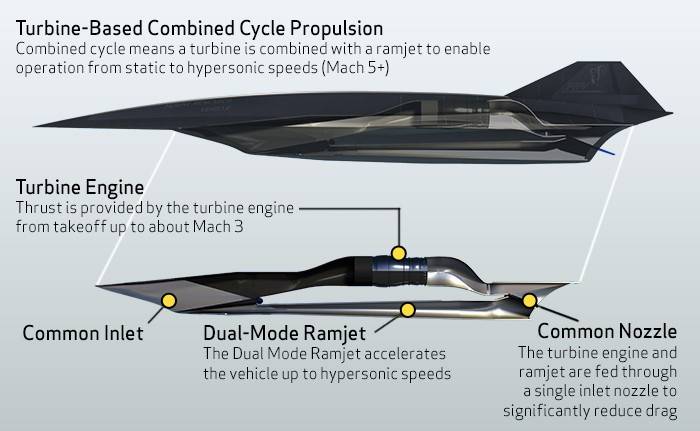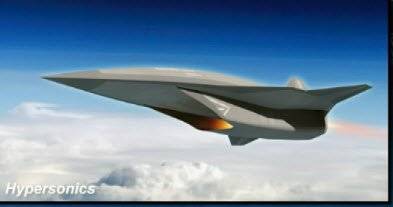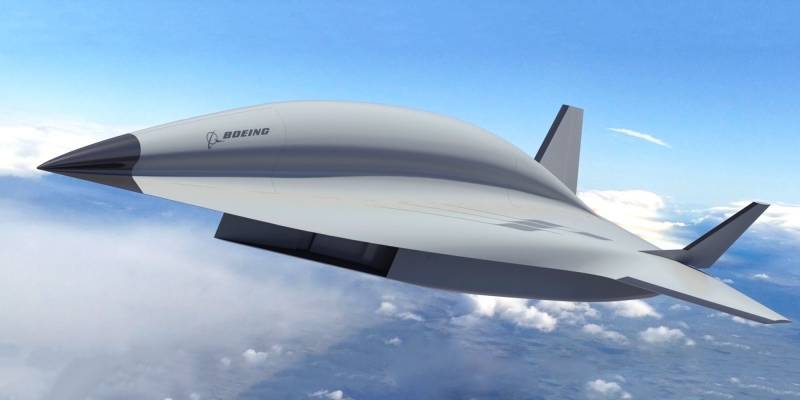Boeing vs Lockheed Martin. New hypersonic race
Participants in the emerging "competition" can be two projects from leading US aircraft manufacturers. This is the project with the conditional name SR-72, created by the designers of "Lockheed-Martin" and the as yet unnamed project from Boeing. It should be noted that equal competition is not out. According to reports, the SR-72 project has already advanced quite far and reached flight tests, at least, of a prototype. The project of the Boeing company, in turn, is still in its earliest stages, involving the study of the overall appearance of the future aircraft.

The first published image of the Lockheed Martin SR-72
Recall that the first mention of a promising project hypersonic aircraft under the brand name Lockheed Martin appeared in 2007 year. Then, at the level of rumors, the topic of the possible creation of a new aircraft, capable of developing the highest speed and suitable for solving various military tasks, was discussed. Among other things, such a machine could become a scout. The latter circumstance led to the appearance of the name SR-72, referring to the famous reconnaissance aircraft SR-71.
Over the next few years, the specialized press repeatedly published materials on the future hypersonic aircraft, but they were not based on official information. The situation changed only in the autumn of 2013, when a special section of the Lockheed-Martin company called Advanced Development Programs (aka Skunk Works) for the first time officially recognized the existence of a promising project called SR-72.
Having announced the existence of the project, the company-developer, however, did not publish the main features of the promising project. Aviation specialists and amateurs again had to rely solely on unofficial estimates and forecasts. However, later some requirements for the future aircraft were announced. In addition, images were published showing the overall appearance of the car.
Over the past years, the developer has clarified some of the provisions of the SR-72 project, which made it possible to form a more complete picture. Thus, it was argued that heat-resistant materials used in the construction of intercontinental ballistic missiles and Space Shuttle spacecraft would be used to combat high temperature loads in the airframe of the future aircraft. The glider will be built from ceramic, carbon-fiber and refractory metal parts. It is also possible to use some solutions that further reduce the load on the aircraft structure.
Even before the appearance of the first rumors about the development of the SR-72 project, it became known that Lockheed-Martin, in collaboration with other organizations, is studying the subject of hypersonic direct-flow jet engines. A few years later, this program was closed, but the new aircraft was not left without a power plant. According to later data, the future intelligence officer will be equipped with combined engines with a turbojet and direct-flow part. Similar engines were previously used on SR-71 aircraft.
According to the published data, the promising hypersonic aircraft will be able to reach speeds of the order of M = 6 (about 6400 km / h) and rise to an altitude of 24-25 km. It is expected that such flight characteristics will make the aircraft invulnerable for modern air defense systems. High speed will not prevent the detection of the machine in flight, but it will not leave the enemy time for the correct response and use of anti-aircraft weapons.

The design of the power plant of the future SR-72
Apparently, the developer company and potential operators have not yet decided on the goals and objectives of the future aircraft. Development of target equipment and weapons, respectively, have not yet begun. According to various estimates, including those made by representatives of Lockheed Martin, the promising SR-72 can be both a reconnaissance aircraft and a platform for strike weapons. At the same time, in both cases the industry will have to face noticeable difficulties.
To use a hypersonic aircraft as a scout, several engineering tasks are required. Thus, the use of aerial cameras requires you to equip the machine with special windows and optical devices that are resistant to the characteristic loads that occur during flight at high speed. The use of electronic intelligence, in turn, is hampered by the fact that a cloud of hot, ionized gas can form around a hypersonic aircraft that can interfere with the transmission of radio waves.
Equipping the SR-72 with weapons is also associated with certain problems. Dropping bombs or launching a rocket at hypersonic speeds is an extremely difficult task. Moreover, such combat use imposes special requirements both on the carrier aircraft and on its weaponry. How exactly these tasks will be solved - if the customer nevertheless wishes to receive a strike aircraft - it remains only to guess. Perhaps the development company itself does not know what steps it should take.
In July last year, reports appeared in the profile editions, from which it followed that the SR-72 project had moved to a new stage. After completing the main part of the design work, Lockheed Martin built and tested the first prototype of the future hypersonic machine. Details of the tests were not published. In this case, the project developer declined to comment and did not even confirm the fact of the first test flight.
While maintaining the required secrecy, Lockheed Martin still publishes certain information about its new project. In particular, quite a long time ago the public showed an approximate look of the future hypersonic aircraft. The official reports in the recent past featured a figure showing a hypothetical SR-72 in flight. He allowed to make a general impression, although he did not disclose the most interesting features of the project.
The official figure depicted a car with a characteristic appearance, which has a number of specific features. In accordance with it, the SR-72 project provided for the construction of an integral-configuration aircraft with a small extension triangular wing with varying sweep of the leading edge. It was proposed to mount the fuselage units, which were made integral with the wing, above the carrier surface. Under the plane was placed a pair of nacelles to accommodate the engine. The tail plumage consisted of only one keel of middle sweep.

New image of hypersonic SR-72
At the beginning of January, a SciTech 2018 conference was held in Kissimmee (Florida), dedicated to advanced science and technology. During this event, Jack O'Bannion, Vice President of Lockheed Martin Advanced Development Programs, told about the completion of work on the unmanned version of the SR-72 hypersonic aircraft. In addition, a slide was shown depicting this machine in its current version. From the shown figure it followed that recently the project could undergo certain changes.
The new version of the SR-72 retains all the main features of the previous one, but differs in the design of the ventral engine nacelle. Instead of two separate volumes for engines, it is now proposed to use only one having an appropriate width. The air intake was also definitely developed.
Earlier it was reported that in the 2018 year should start the construction of a large-scale prototype model, designed for new flight tests. This product may receive not only automatic control systems, but also a full cockpit. The new prototype will have a length of about 18-20 m and will receive a new type of engine, with the help of which it will be able to speed up to M = 6 for a short time. It is expected that by the middle of the next decade the prototype will be able to take to the air and show the desired characteristics.
If the work continues and can lead to the desired result, then by 2030, the US Air Force will be able to get the desired reconnaissance or strike aircraft with uniquely high performance. Nevertheless, before the launch of mass production, the industry and the military will have to solve a number of very serious problems. From this will depend on the fate of the project.
As part of SciTech 2018, a recent science and technology forum, Boeing has revealed its plans for hypersonic aircraft. She has been researching this area for quite a long time, and is now ready to start developing a promising project. Already considered several options for the appearance of the future aircraft and selected suitable for further development. One of the acceptable variants of the technical appearance was presented in the form of a three-dimensional image.
Specialists of the company "Boeing" propose to build a plane "tailless" scheme with a delta wing with a broken leading edge. With the upper surface of the wing must be connected fuselage complex curved shape, characterized by a variable cross section and varying height. In the tail above the wing, it is proposed to place a pair of carinae that are spread out. Under the wing, on the longitudinal axis of the machine, there must be a large engine nacelle. The air intake is proposed to equip a vertical wedge.
According to representatives of the company-developer, a similar look of the future hypersonic aircraft has not yet been approved and adopted for further development. Nevertheless, it is already recognized as one of the most successful and promising, and, apparently, it will be implemented as part of a full-fledged project.
From the available data it follows that the development of a hypersonic aircraft under the brand name Boeing has not yet begun. Using the existing experience, the specialists of this company chose the most successful version of the architecture of the future machine, but have not yet begun to elaborate on the project. Development work will have to start in the near future and take several years. The deadlines for the completion of the project and for obtaining real results, for obvious reasons, are not yet specified.
It is reported that the company "Boeing" intends to solve the main tasks of the new project with the help of well-known ideas, including those already used in the SR-72. The future airframe will be built using various materials capable of withstanding high mechanical and thermal loads. For flying at low, super- and hypersonic speeds, it is planned to use combined engines combining units of turbo-jet and direct-flow systems.
It is expected that the aircraft from Boeing will be able to reach a speed of at least M = 5 and solve various problems. It is estimated that it can be used as a reconnaissance or strike aircraft. In addition, the possibility of creating a truck or a passenger car for use in commercial air travel is not excluded. However, while the project is at its earliest stages, when uncertainty can be preserved not only in the area of technical issues, but also in the sphere of goals and objectives.
Currently, several US companies and organizations are engaged in the subject of hypersonic aircraft for various purposes. One of the most interesting directions in this area is the creation of airplanes suitable for solving practical problems. The leader of this direction at the moment is Lockheed Martin, which so far has managed not only to develop the project, but also, according to the available data, to test the first prototype, as well as to prepare for the construction of a new prototype.
Another major aircraft manufacturing company, Boeing, also managed to develop and test several prototypes, including those characterized by high airspeed. However, she is not yet ready to submit a draft aircraft suitable for use in practice. To date, experts have chosen the most successful version of the appearance of such an aircraft, which is planned to be developed as part of further work.
Thus, according to the results of all previous work that lasted for several years, Lockheed Martin was in the role of a leader with a certain lead over competitors, while Boeing has yet to catch up with it. Who will emerge victorious from such a race - for the time being it is impossible to speak with confidence. Hypersonic direction is extremely difficult to master, and therefore at any time the leader may encounter certain problems due to which he will lose his position.
Anyway, in the USA a new “arms race” is being planned with the participation of its own enterprises, this time in the field of hypersonic aircraft. New results of the two largest companies will have to appear in the near future. What they will be and what they will lead to will be known later.
On the materials of the sites:
http://aviationweek.com/
https://lockheedmartin.com/
https://futurism.com/
http://popularmechanics.com/
http://globalsecurity.org/

Information